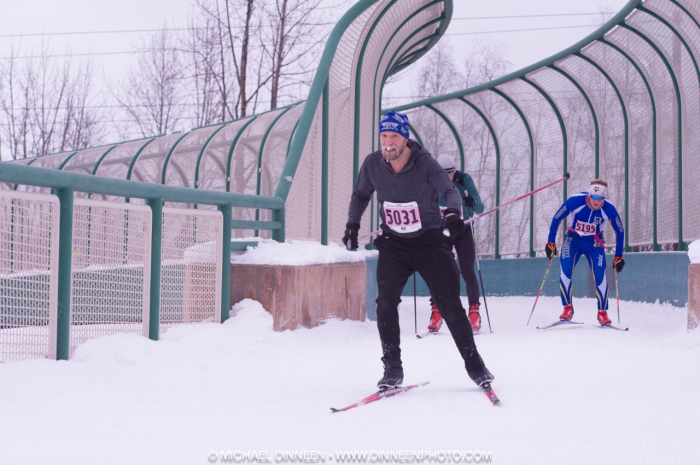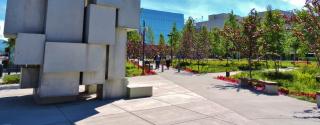Olympic Gold medalist Kikkan Randall has skied in countless places around the globe and boasts that her hometown Tour of Anchorage race offers something unmatched.
“It’s such a cool opportunity to race point-to-point in an urban environment,” says Randall, now a retired racer and executive director of the Nordic Skiing Association of Anchorage, which organizes the TOA. “That’s something I haven’t seen anywhere else.”
Many ski marathons follow a loop and avoid urban areas, for obvious reasons — it’s not easy, or necessarily desirable, to ski through most cities. Not the Tour of Anchorage, which starts at Service High School on the Hillside and ends at Kincaid Park overlooking Cook Inlet.
Not a single road is crossed, a small miracle made possible by using greenbelts and multiuse trails that include tunnels, bridges, and underpasses. Trails in the woods or along the coast are seamlessly mixed with routes that pass through neighborhoods and border busier roads.
The event began in 1988, the winter after the Tony Knowles Coastal Trail was completed. Because no pedestrian bridge existed then, 170 intrepid skiers had to cross a busy Tudor Road where police stopped traffic and a carpet was laid down for safe passage.
The Tour has come a long way since then. By the early 2000s, TOA was drawing upwards of 2,000 racers, making it among the largest Nordic ski events in North America. Participation now totals around 1,000 a year as skiers and snow bikers of all levels race — or tour — 25, 40 or 50 kilometers (31.1 miles).
Snow bikers? Indeed. Acknowledging the growing popularity of fat biking, which originated in Alaska, the TOA in 2019 became the only event in the country to allow bikers to race the same course on the same day as the skiers (the bikers start in the afternoon to limit overlap). The bikers are generally faster than the skiers —the 50K bike record is 1 hour, 55 minutes while no skier has ever broken two hours — although in soft snow years the skiers have an advantage. The TOA is a unique opportunity for bikers to ride on trails including the arduous Spencer Loop and flowy Sisson Trail that are otherwise off-limits to them. The most ambitious bikers will first ski 50 kilometers, take a short break and then bike another 50K to complete the “Tour Double” category!

Photo by: Andy Romang
I haven’t doubled (not yet), but I do have a personal history with the TOA.
In one of my first ski marathons about 20 years ago, I broke part of my binding in the race’s first kilometer. Unwilling to cut my losses, I spent the next 49K struggling with an improvised technique but managed to finish. Many years later I improved enough to place among the top 30 overall despite identifying myself more as a mountain runner than a ski racer. In 2014, I recall the frantic finish on a narrow trail into Alaska Pacific University after the race was shortened to 26K due to poor snow conditions along the coast. Another year I was caught by the lead women halfway through — they start several minutes after the men — and witnessed the competitive women’s race unfold. And from 2018-2021, my TOA experience came full circle as I directed the event (with help from NSAA) and implemented measures such as adding the bike races, music to the starts, and a finish outside the Kincaid Chalet.

Photo by: Michael Dinneen
It should be noted that the Tour of Anchorage trail can be enjoyed by foot travelers, bikers, or skiers. Starting at Service High School, one connects to the Homestead Trail that heads downhill and before long merges into Far North Bicentennial Park and the magical Campbell Tract.
Countless singletrack trails created by fat bikers branch off through here. Once you exit Bicentennial Park, the urban section is evident, with bridges over Tudor and Northern Lights roads and paths near East Anchorage High School (Randall’s alma mater), the University of Alaska Anchorage, and Alaska Pacific University. The latter hosts the 25K start near University Lake. There are also opportunities to detour on trails to Campbell Creek, Goose Lake, or Russian Jack Springs Park.
Chester Creek Trail, with its numerous tunnels and ever-present creek, is shared with the Iditarod on race weekend; the ceremonial start is on a Saturday and the TOA is always on Sunday.
Chester Creek ends at the bustling Westchester Lagoon, where skaters and hockey players join the mix. Then it’s a hard left onto the Coastal Trail (or head downtown with a right turn).
The Coastal Trail features interesting snow and mud formations on the tidal flats, not to mention Mount Denali to the north on clear days. The trail also gradually becomes wilder when you enter Point Woronzof Park, and moose sightings are common enough that you need to bushwhack around them. The Coastal Trail eventually ends at Kincaid Park, completing a tour that can be accomplished in one outing or several.
Follow these links to learn more about cross-country skiing and fat tire biking in Anchorage.
Matias Saari
Matias, a former sportswriter at the Fairbanks Daily News-Miner, is a coordinator for Healthy Futures, the signature program of the Alaska Sports Hall of Fame. He directs the Mount Marathon Race, an event he won in 2009, along with the Crow Pass Crossing and Kesugi Ridge Traverse. He won Fairbanks’ Equinox Marathon six times and wrote a book about its history. He especially enjoys reporting on skiing, running, biking and mushing. Matias regularly accesses mountains and trails from his doorstep in Bear Valley on the Anchorage Hillside.


